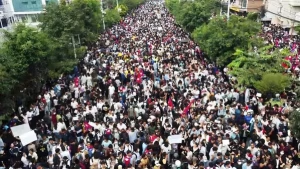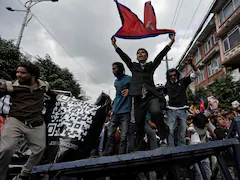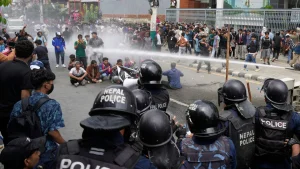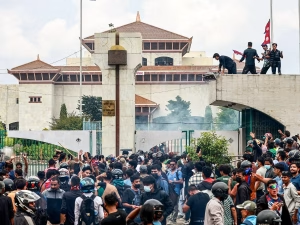Nepal – A devastating Nepal protest erupted on Monday as thousands of demonstrators took to the streets of Kathmandu and other cities to oppose the government’s controversial ban on major social media platforms. The protests, primarily led by young people dubbed “Gen Z protesters,” have resulted in significant casualties and political upheaval across the nation.
The Nepal protest began as peaceful demonstrations but quickly escalated into violent confrontations between security forces and protesters. Young demonstrators, many wearing school and college uniforms, breached restricted zones and stormed Parliament premises, forcing authorities to impose emergency measures across multiple cities.
Home Minister Steps Down Amid Crisis

In a significant political development, Nepal Home Minister Ramesh Lekhak tendered his resignation during a cabinet meeting with Prime Minister KP Sharma Oli. The resignation came as the death toll from the Nepal protest reached 19 people, with over 200 others sustaining injuries in clashes across the country.
Lekhak’s decision to step down reflects the gravity of the situation and the mounting pressure on the government to address the crisis. The resignation marks a crucial turning point in the ongoing Nepal protest that has gripped the nation for hours.
Casualties Mount Across Multiple Cities


The Nepal protest has extracted a heavy human cost, with 19 confirmed deaths reported across different locations. Sixteen fatalities occurred in Kathmandu Valley, while two deaths were recorded in Itahari when police opened fire on demonstrators. The remaining casualty was confirmed in other protest locations.
More than 200 people have been injured during the violent clashes, highlighting the intensity of the Nepal protest movement. Among the injured was television journalist Shyam Shrestha, who was struck by a rubber bullet fired by police during confrontations at Baneshwar in Kathmandu and is currently receiving treatment at Civil Hospital.
Government Response and Emergency Measures


Prime Minister KP Sharma Oli convened an emergency cabinet meeting to address the escalating crisis. The Nepal protest has prompted authorities to deploy heavy security forces and implement curfews in multiple cities including Kathmandu, Butwal, and Bhairahawa.
Also Read: Russia Pounds Ukraine Govt: Devastating 800 Drone Missile Attack
The Nepalese army was deployed to control the situation as protesters overwhelmed riot police, forcing them to retreat in several locations. Curfews were imposed in high-security zones including Parliament, the government secretariat, and the presidential palace.
Protesters Target Political Leadership

The Nepal protest extended beyond Kathmandu, with demonstrators in Damak hurling stones at Prime Minister Oli’s residence in his hometown. Police responded with warning shots as protesters blocked the East-West Highway and set fire to tires at multiple locations, disrupting vehicular movement for over an hour.
Protesters also vandalized Parliament gates and breached security perimeters, demonstrating the widespread nature of the Nepal protest movement. The demonstrators expressed their determination, with one protester stating that those in power could not “impose their power on us.”
Root Cause: Social Media Platform Restrictions
The Nepal protest originated from the government’s decision to ban 26 social media platforms, including Facebook, X (formerly Twitter), and YouTube. The ban was implemented after these companies allegedly failed to register officially with Nepalese authorities and comply with government oversight requirements.
The restriction came into effect on Thursday midnight following a Supreme Court ruling that upheld requirements for social media platforms to register locally to address misinformation concerns. However, platforms like TikTok, Viber, and three others that had completed registration continued operating normally.
International Border Security Heightened
The Nepal protest has prompted increased vigilance along the India-Nepal border. Sashastra Seema Bal officials have stepped up monitoring and issued alerts considering the ongoing unrest. Border security forces are maintaining close surveillance of developments to prevent any spillover effects.
Government Considers Policy Reversal
Sources indicate that the Nepal government is likely to revoke the social media ban following the violent escalation of the Nepal protest. The mounting casualties and widespread unrest have apparently forced authorities to reconsider their controversial decision that sparked the nationwide demonstrations.
Conclusion: Crisis Demands Immediate Resolution
The Nepal protest represents a critical moment in the country’s recent political history, highlighting the power of youth activism and the consequences of restrictive digital policies. With 19 lives lost and hundreds injured, the government faces immense pressure to resolve the crisis through dialogue and policy adjustments.
The resignation of the Home Minister and potential reversal of the social media ban signal the government’s recognition of the gravity of the situation. As emergency measures continue across multiple cities, the coming hours will be crucial in determining whether authorities can restore peace and address the legitimate concerns raised by the protesters.

